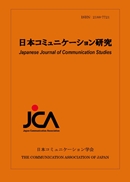Volume 43, Issue 2
Displaying 1-10 of 10 articles from this issue
- |<
- <
- 1
- >
- >|
Cover, Contents
-
Article type: Cover
2015Volume 43Issue 2 Pages Cover1-
Published: March 31, 2015
Released on J-STAGE: May 17, 2017
Download PDF (20962K) -
Article type: Contents
2015Volume 43Issue 2 Pages 79
Published: March 31, 2015
Released on J-STAGE: May 17, 2017
Download PDF (18K)
Special Feature
-
Article type: Article
2015Volume 43Issue 2 Pages 81-87
Published: March 31, 2015
Released on J-STAGE: May 17, 2017
Download PDF (581K)
Articles
-
Article type: Article
2015Volume 43Issue 2 Pages 89-108
Published: March 31, 2015
Released on J-STAGE: May 17, 2017
Download PDF (1952K) -
Article type: Article
2015Volume 43Issue 2 Pages 109-124
Published: March 31, 2015
Released on J-STAGE: May 17, 2017
Download PDF (1530K)
Journal Information
-
Article type: Appendix
2015Volume 43Issue 2 Pages 125-126
Published: March 31, 2015
Released on J-STAGE: May 17, 2017
Download PDF (119K) -
Article type: Appendix
2015Volume 43Issue 2 Pages 126-127
Published: March 31, 2015
Released on J-STAGE: May 17, 2017
Download PDF (93K) -
Article type: Appendix
2015Volume 43Issue 2 Pages 128-129
Published: March 31, 2015
Released on J-STAGE: May 17, 2017
Download PDF (131K) -
Article type: Appendix
2015Volume 43Issue 2 Pages 130-132
Published: March 31, 2015
Released on J-STAGE: May 17, 2017
Download PDF (158K) -
Article type: Appendix
2015Volume 43Issue 2 Pages App5-
Published: March 31, 2015
Released on J-STAGE: May 17, 2017
Download PDF (39K)
- |<
- <
- 1
- >
- >|
